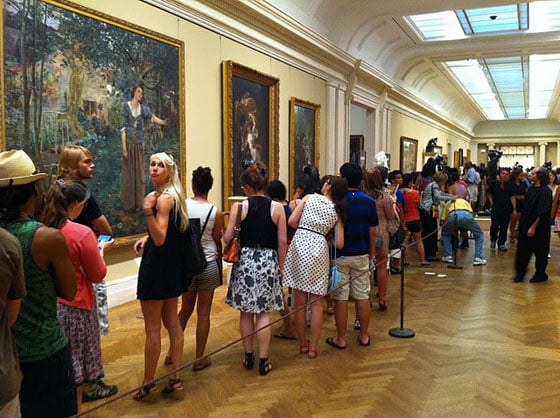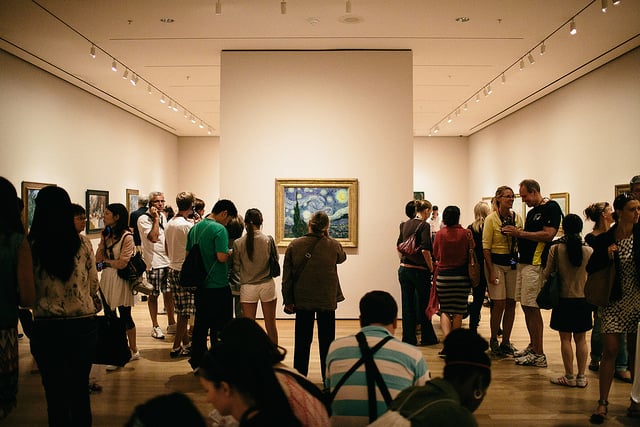Art & Exhibitions
Have New York Museums Hit Their Peak?
What's a museum to do to get visitors through the front doors?

What's a museum to do to get visitors through the front doors?

Philip Boroff

Big as they are, crowds at New York’s marquee art museums have been bigger.
For example, the Museum of Modern Art, the city’s largest private museum, last celebrated record attendance back in 2009–10. Now it’s in a position to surpass those 3.22 million visitors—by a whisker. For the 12 months ending on June 30, “if projections are met, it is possible we could reach 3.24 million,’’ Kim Mitchell, a MoMA spokesperson, said in an e-mail last week. As of late May, MoMA recorded 2.9 million attendees, with such exhibits as “Magritte: The Mystery of the Ordinary’’ and a retrospective of the German painter and photographer Sigmar Polke. June should be suspenseful.
Attendance is a measure of vitality and key source of revenue. MoMA’s admission fees brought in $28.5 million in 2012-13—17 percent of what it collected in operating revenue, donations, and investment income. Attendance also affects membership, retail sales, and restaurant sales. Records are generally driven by so-called blockbuster shows and tourism, museum directors and consultants say.
What should be made of the fact, then, that New York tourism growth has slowed? The number of visitors to the city rose a total of 15 percent over the five years ending in 2013, down from 25 percent growth in the preceding five years, according to NYC & Co., the city’s tourism organization. “Tourism is going up each year so I don’t categorize that as slowing,” Chris Heywood, an NYC & Co. spokesperson, said in an e-mail. The number of international visitors is growing “exponentially” and they tend to stay longer and spend more than their domestic counterparts, he said.

A Crowd of visitors at the Museum of Modern Art.
Photo: via flickr.
A tougher time drawing crowds
Nonetheless, record numbers at other museums also have been in short supply lately. The Guggenheim’s attendance crested in 2009, with 1.3 million. Admissions this year lag 2013 by 3 percent, spokesperson Betsy Ennis said. The Metropolitan Museum of Art’s busiest season in the museum’s 141 years was 2011–12, with 6.28 million visitors. It’s on track for a second consecutive decline, according to statistics released by Met spokesperson Elyse Topalian. The Whitney’s peak was 2009–10, with 372,000. (Spokesman Charlie Tatum declined to release numbers for 2013–14. Like MoMA, the Met and Whitney’s fiscal year ends on June 30.)
Museums nationwide apparently are having a tougher time drawing crowds. About a fifth of adults surveyed by the National Endowment for the Arts in 2012 visited a museum or art gallery, down from a quarter a decade earlier. “We don’t see anything that suggests a falloff,’’ said Thomas Campbell, the Met’s director and chief executive officer, in a telephone interview. “Where you have a challenge is museums in cities that have less tourist traffic.’’
Campbell attributed this season’s modest Met decline to the harsh winter, resulting in airlines cancelling thousands of flights to New York; and the ongoing construction of the four-block-long David H. Koch Plaza, which may suggest to some potential visitors that the museum is closed. Campbell also characterized some current offerings as “scholarly’’ and “esoteric.’’ In contrast to “Early Renaissance Drawing in Verona’’ and “Design Motifs in Byzantine Art,’’ last season featured “Regarding Warhol: Sixty Artists, Fifty Years’’ and “PUNK: Chaos to Couture.’’ And those popular exhibits were overshadowed by the Gothic couture of “Alexander McQueen: Savage Beauty.’’ It attracted 660,00 visitors by the time it closed on August 7, 2011, making it the Met’s eighth most-popular exhibit ever and boosting attendance for 2009–10 and 2010–11.

Visitors on line to see “Alexander McQueen: Savage Beauty” at the Metropolitan Museum of Art
Photo: Courtesy artnet.
More than a quarter of tourists the Met surveyed in 2011 in an in-house economic-impact study said that special exhibits were a factor in their decision to visit New York. MoMA’s busy 2009–10 was buoyed by the drawings, images, and storyboards of film director Tim Burton and a retrospective of Marina Abramović, featuring the performance artist’s marathon staring. The Guggenheim’s 2009 season included its heavily promoted 50th anniversary and an exhibit of Frank Lloyd Wright, the architect who designed its Fifth Avenue building. Ennis, the spokesperson, said the Guggenheim closes much of its interior an average of 75 days a year to replace exhibits and even when fully open, it caps attendance at 4,500 to 5,000 a day. “Limited capacity translates to long lines, which many visitors opt out of,’’ she said.
While blockbusters, or “super-exhibits” generate press, Maxwell Anderson, director of the Dallas Museum of Art, wrote in the essay “Metrics of Success of Art Museums’’ that they “increasingly result in red ink’’ because of the escalating costs to mount them. In an interview, he called attendance “a symptom of an institution’s performance.’’
“We don’t look at attendance as the primary marker of success at all.”
Likewise, consultant Adrian Ellis said focusing on attendance at a world-class institution “is like looking at an elephant through a keyhole. It’s distorting.” MoMA Director Glenn Lowry said while admissions are important for balancing his budget, he’s principally concerned with the impact and quality of programming. “We don’t look at attendance as the primary marker of success at all,’’ he said in a telephone interview. MoMA doesn’t intend to grow attendance dramatically, he said. It expanded to seven days a week a year ago, he said, to “spread out’’ visitors and improve their experience, not to increase their ranks.
But MoMA’s disclosures suggest it seeks to portray admissions in the best light. In a December 2012 filing for bondholders, it revised upwards four years’ of attendance to include visitors of PS1, the contemporary gallery in Queens that MoMA acquired in 2000. MoMA boasted in a December 2013 bond filing that in 2012–13 it reached “over 3 million visitors for only the third time in the museum’s history.’’ Without PS1, now called MoMA PS1, the museum surpassed 3 million visitors once, in 2009–10. Mitchell said: “We felt that the organization had reached a point of integration and cross-collaboration that it made sense’’ to add in PS1’s numbers.
Linda Cheu, an economist who studies museum attendance at AECOM, a Los Angeles–based engineering and consulting company, said it may not be a coincidence that attendance at some museums peaked around the financial crisis.
“They benefited from ‘staycations,’’’ she said. “They’re a substitute for leisure products that are more expensive. It’s possible that people are diversifying their leisure activities again.’’ But Arthur Cohen, the chief executive of LaPlaca Cohen, a cultural advertising and strategy firm, said the cultural market remains robust. He called the Whitney’s relocation to its Renzo Piano building downtown next year a “transformational event’’ that should boost its numbers.
“When the next great ‘super-exhibit’ is created, at the Met, MoMA, or wherever,’’ he said, “I see no reason why attendance can’t rise to levels not previously experienced.’’